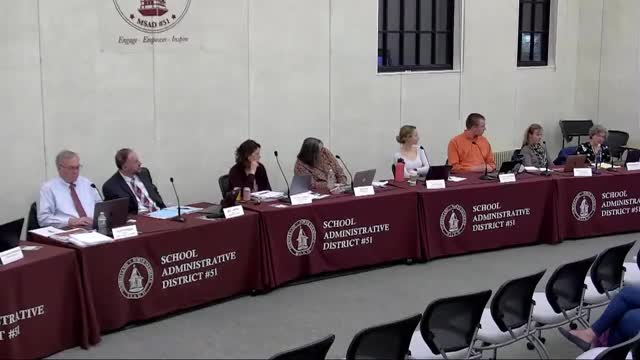School Board debates turf field funding amid new school project concerns
March 18, 2024 | RSU 51/MSAD 51, School Districts, Maine

This article was created by AI summarizing key points discussed. AI makes mistakes, so for full details and context, please refer to the video of the full meeting. Please report any errors so we can fix them. Report an error »

In the heart of Maine, the MSAD 51 School Board convened on March 18, 2024, to discuss pivotal developments that could shape the future of education and community engagement in the district. As board members gathered, the atmosphere was charged with a mix of anticipation and concern, particularly surrounding the proposed new school and the contentious issue of a turf field.
The meeting highlighted the board's commitment to a comprehensive approach to education, emphasizing that the new school is not merely an addition but a necessary evolution to meet the needs of all students. One board member passionately articulated the importance of addressing not just the school’s infrastructure but also the safety and functionality of the surrounding facilities, including the much-debated turf field. “We can’t send them to lower grades and then say, yeah, when you get older, you’re just gonna have to run around in the mud,” they remarked, underscoring the need for safe and reliable athletic spaces.
A significant point of discussion was the financial implications of the proposed projects. The board noted a substantial reduction in the projected costs, dropping from $76 million to $53 million, which they argued would alleviate some tax burdens on the community. “Please hear us that, yeah, it’s going to affect your taxes, but nothing like it would have,” one member urged, hoping to reassure concerned taxpayers about the financial viability of the plan.
The conversation also turned to the potential for community fundraising to support the turf field, with members suggesting that grassroots efforts could help offset costs and allow for more flexibility in budgeting. “If there was a fundraising effort around the turf field, that money can be used for... returned to taxpayers,” one member explained, highlighting the possibility of community involvement in financing the project.
However, not all board members were in agreement about including the turf field in the overall package. Some expressed concerns that separating the turf field from the main project could lead to its exclusion if budget constraints arose. “I think we owe it to them to give them that choice,” one member stated, advocating for a clear decision from voters on the turf field’s inclusion.
As the meeting progressed, the board members reflected on the broader implications of their decisions, recognizing that the new school and improved facilities would serve not just current students but the entire community. “It’s a community event,” one member noted, emphasizing the role of the campus as a central hub for local activities.
With the vote approaching, the board is poised to present a unified vision for the future of MSAD 51, one that seeks to enhance educational opportunities while addressing the needs and concerns of the community. As they prepare to finalize the details for the upcoming referendum, the discussions from this meeting will undoubtedly resonate with voters, shaping the landscape of education and community engagement in the district for years to come.
The meeting highlighted the board's commitment to a comprehensive approach to education, emphasizing that the new school is not merely an addition but a necessary evolution to meet the needs of all students. One board member passionately articulated the importance of addressing not just the school’s infrastructure but also the safety and functionality of the surrounding facilities, including the much-debated turf field. “We can’t send them to lower grades and then say, yeah, when you get older, you’re just gonna have to run around in the mud,” they remarked, underscoring the need for safe and reliable athletic spaces.
A significant point of discussion was the financial implications of the proposed projects. The board noted a substantial reduction in the projected costs, dropping from $76 million to $53 million, which they argued would alleviate some tax burdens on the community. “Please hear us that, yeah, it’s going to affect your taxes, but nothing like it would have,” one member urged, hoping to reassure concerned taxpayers about the financial viability of the plan.
The conversation also turned to the potential for community fundraising to support the turf field, with members suggesting that grassroots efforts could help offset costs and allow for more flexibility in budgeting. “If there was a fundraising effort around the turf field, that money can be used for... returned to taxpayers,” one member explained, highlighting the possibility of community involvement in financing the project.
However, not all board members were in agreement about including the turf field in the overall package. Some expressed concerns that separating the turf field from the main project could lead to its exclusion if budget constraints arose. “I think we owe it to them to give them that choice,” one member stated, advocating for a clear decision from voters on the turf field’s inclusion.
As the meeting progressed, the board members reflected on the broader implications of their decisions, recognizing that the new school and improved facilities would serve not just current students but the entire community. “It’s a community event,” one member noted, emphasizing the role of the campus as a central hub for local activities.
With the vote approaching, the board is poised to present a unified vision for the future of MSAD 51, one that seeks to enhance educational opportunities while addressing the needs and concerns of the community. As they prepare to finalize the details for the upcoming referendum, the discussions from this meeting will undoubtedly resonate with voters, shaping the landscape of education and community engagement in the district for years to come.
View full meeting
This article is based on a recent meeting—watch the full video and explore the complete transcript for deeper insights into the discussion.
View full meeting
